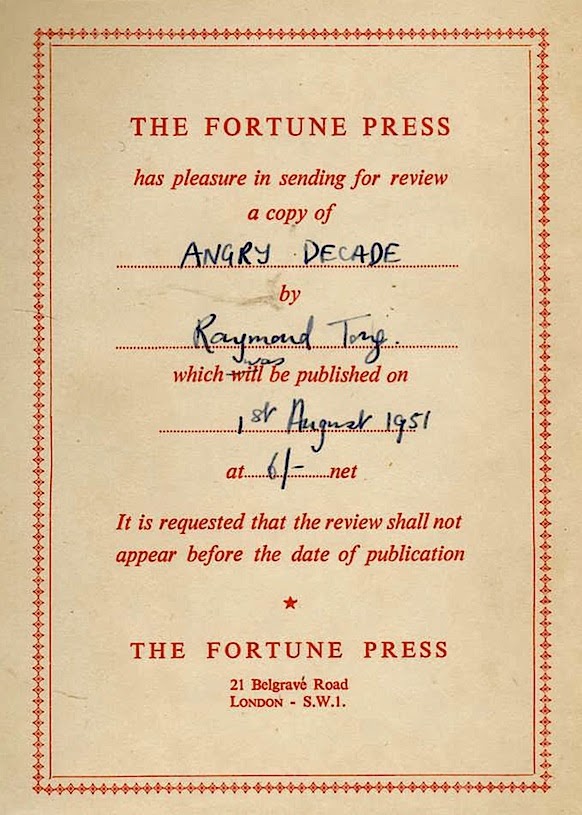Discovered in a copy of Raymond Tong’s Angry Decade, a slim volume brought out by the famous Fortune Press in August 1951, is that rarest of objects—a review slip inscribed in the handwriting of the actual publisher, R. A. Caton—known to his friends (if he had any) as 'Reggie'. Nowadays a publisher’s slip like this would normally be filled in by some unpaid, starry-eyed intern with a B.A.(Hons) in Englit. But much as penny-pinching Reggie would have welcomed free help back in 1951, any new graduate would probably have walked out of his basement HQ in Belgrave Road, before a week had elapsed, so unpleasant, by all accounts, was this particular employer. One Fortune Press author, Margaret Crosland, told me that Caton looked like 'a second-rate accountant, wearing the traditional dirty raincoat, on his way to a sex shop.'

'The Fortune Press' , Philip Larkin complained in 1945, 'is only a yelping-ground for incompetents who can’t get a hearing elsewhere' . At the time Larkin had just posted his novel Jill to Caton, who was also preparing to bring out his debut collection of poems, The North Ship. The protracted publication of both books and the censorship of Jill by Caton (himself, ironically, a publisher of mild homosexual porn) kept their author in a fury of irritation and frustration for years —a state of mind which was soon to be shared by his friend Kingsley Amis, whose own first slim volume, Bright November was also to be taken on by Caton. Both men concocted private, long-running jokes about their publisher, and according to Larkin, Amis never lost an opportunity of introducing the seedy publisher into his novels, sometimes under a thinly disguised pseudonym.
But for all his tardiness and physical repulsiveness, Caton was a visionary who was responsible for bringing out more debut volumes by good poets than just about any other publisher in the UK. And considering that he operated alone, this is an astonishing achievement. Having begun in 1925 as the vanity publisher of C Day Lewis’s now almost unobtainable Beechen Vigil, by 1939 had published some of the earliest work by Lawrence Durrell, and by the end of the war had taken on Gavin Ewart, Roy Fuller Julian Symons, Henry Treece, Nicholas Moore, Francis Scarfe, Tambimuttu, and Drummond Allison. In all, he published more than 600 books between 1924, when he set up his press, and the late sixties, when he finally shut up shop. He died in 1971.
Neither Amis nor Larkin received a penny for their work , but Caton did manage to recompense a few (in Inside the Forties Derek Stanford, who gives a graphic description of his dealings with the publisher, claimed to be one of the lucky ones). Many were happy to pay Caton for the thrill of seeing their poems in print. In return Caton, by listing his authors and their works on the backs of each dust jacket, made his customers feel as valued as any of the poets of the more eminent houses, such as Faber. At the same time he cut corners to keep down costs. Apparently, in the early years of the war, he stockpiled a huge amount of cheap binding cloth of various colours and textures, which accounts for the variety of bindings you can find. In contrast, by the fifties, when presumably Caton had become more prosperous, you could buy copies of Terence Greenidge’s Girls and Stations (1952), in mock alligator skin bindings. [RMH]

Big ups to the British Kahane (or Girodias)! I have a copy of the Fortune Press publication of Against the Grain bound in what looks like vellum. The limitation of the entire publication is claimed to be 250 (although I'm not sure if Caton was as unreliable as his French counterparts in this respect). Anyone have any idea what the limitation on the vellum issue was? A bookseller (Rota maybe) has written "1 of 25?" in my copy but anyone know for sure? Much appreciated.
I think Rota bought a big load of Fortune Press back in the 1970s and a lot of it entered the London trade so one continually saw books by Fowkes and Quinterley (same bloke?) and poetry sections in second hand shops were stuffed with their slim vols. Later Any Amount got a load from Scotland and after that Delectus. The Rota note is probably reliable and based on trade lore or even observation but Tim D'Arch Smith's bibliography may nail it/
Yes. Aubrey Fowkes and Esmond Quinterley were the same person, real name Richard Vere Cripps, the author of, I think, 23 books none of them issued under his own name. I guess his identity was kept secret to avoid embarrassing his family but since his sister died in 2004 I see no need for further obfuscation
Thanks very much.
For many years I have been trying to locate the source of a poem I copied into an old notebook some 65 years ago! Yes, that is not a misprint! It was called Death of a Partisan and apparently was part of a longer verse called Salute to Greece. I did not know the poet. This was decades pre-Google. Recently I discovered the notebook and Google suggests it might be Raymond Yong, but nowhere can I obtain he slim book of verse entitled Salute to Greece. Does anyone know of it, and if it contains the section entitled Death of a Partisan – which begins "Suddenly music burst out of his wounds . . ."
Correction to my previous post – name should be Raymond Tong (not Yong).
Raymond Tong did 3 collections of poetry with Caton's Fortune Press in 1942, 1946 and the last called 'Angry Decade 1940-1950' came out undated in 1951. Your poem could be in one of those 3 books – a few show on abebooks.com. Good luck.